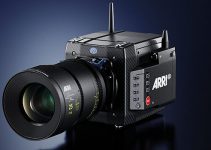Founded in 1982, Televisual has been the leading monthly trade publication covering the UK broadcast industry for decades. And they just published the results of their 2014 Annual Technology Survey, which includes the opinions of 100 senior productions staff at leading TV, film, commercials and corporate production companies in the UK on which camera systems and post-production kit they used in their productions and what producers thought of their choices.
Keep in mind this is not a “best of” list, but simply a representation of the preferences of major production companies in the UK towards camera systems and editing, compositing, and colour-correction software.
Here’s a snapshot of the breakdown of the participants in the 2014 Technology Survey:
58% of respondents said they manage the production budget and are responsible for the production and technology choices. Meanwhile, 25% said they manage the production budget, and take advice on technology choices.
11 heads of production, four directors of production, 10 production managers, six managing directors, five heads of post production, 13 producer/directors, five exec producers and three series producers were among the 100 respondents to the survey.
73% said they work in TV production. 21% work in corporate, 13% in film, and 9% in commercials. (Some work in several sectors, explaining why the total is more than 100%).
With technology in production evolving and changing fast, and new cameras and post-productions solutions popping up from every direction, it is a challenge to keep up with the current trends in the broadcast, commercials, and corporate production arena.
The survey focuses on the following key areas:
1. Most Popular Cameras used in the 12 Months Prior
- Cameras used by participants in the last 12 months:
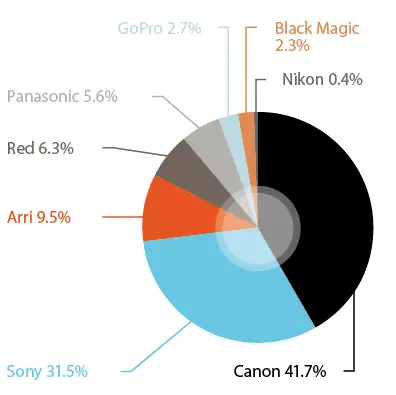
Canon leads the pack here, and not that’s no surprise at all. Canon branded cameras have been the most popular camera in the UK broadcast industry in the past year with around 42% market share. The XF305 has been used by major broadcasters like the BBC and ITV regularly. Canon has a loyal following with 30.5% of those asked say they are considering shooting on Canon cameras again in the next 12 months. 22% of all respondents said the Canon EOS C300 was the camera they used most frequently.
The C300’s robust and broadcast friendly codec, stunning 1080p scaled down from a 4K sensor, incredible low-light performance, bundled with professional connections such as XLR and HD-SDI gives the Canon C300 the upper hand in this part of the survey.
Sony trails with around 32%, and that would probably be rising in the next year, as their PMW-F5/F55 cameras are gaining significant popularity among production and rental houses due to their reliability, ability to shoot in multiple resolutions 1080p/2K/4K and Sony’s respected heritage in the broadcast industry. Sony’s massive camera line-up also contributes to their steady numbers with the PMW-200/300 being very popular among broadcasters and documentary shooters.
RED Epics/Scarlets are following ARRI, whose film industry work-horse Alexa, has been the camera of choice on bigger budget commercials, and narrative TV dramas. Panasonic are behind with only a 5.6% of the participants using their cameras in the prior 12 months. At the bottom of the chart we see GoPro with 2.7%, Blackmagic Design with 2.3% and Nikon with a 0.4%. These three brands are relatively new entrants and chances are we’d see more of them in future years.
- Cameras participants are planning on shooting on in the next 12 months:
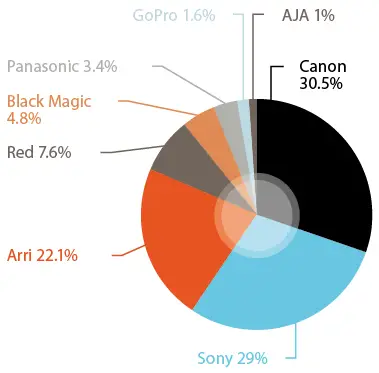
The upcoming ARRI Amira certainly gave the legendary German film equipment manufacturer a massive boost here. Targeting one-man operations, documentary and TV production shooters, the ProRes native AMIRA has a lot to offer – a solid broadcast codec, legendary build quality and pedigree, lens options, ergonomics and high-speed options going up to 200fps. Canon and Sony are going head to head here, and with the AMIRA in the mix, the next 12 months will be quote the “Battle Royale” between the three camera behemoths.
RED (thanks mostly to their smashing new 6K Dragon sensor) are claiming a bigger chunk of the pie here, as the RED Epic is already one of the most common cameras on slow-motion intensive commercials, music videos and high-end corporate work.
The GH4 is giving Panasonic a much needed boost (and so is the A7s for Sony). BlackMagic Design are also showing an increase in numbers and with the upcoming 4K URSA and the continuous adoption of the original BMCC and the 4K BMPC that shouldn’t be a surprise at all.
2. Most popular editing and grading software
- Editing Software
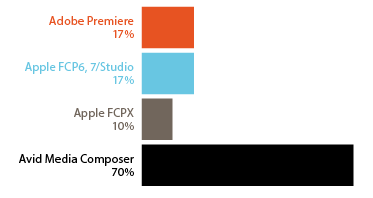 Avid Media Composer remains the industry standard as the editing system of choice for 70% of the participating UK production professionals.
Avid Media Composer remains the industry standard as the editing system of choice for 70% of the participating UK production professionals.
Avid is demanded as by most editors and has been a market leader for the past two decades. “Avid” (no pun intended) Avid users value the software’s rich feature set, widely adopted support, reliability, and ease of workflow amongst the major factors why they’d chose Media Composer over competitor products from Apple or Adobe.
TV series and most broadcast productions are heavily reliant on multi-camera support and compatibility in the workflow pipeline, as work gets shared sometimes among many editors, and this is where the power of Avid comes.
Apple’s successor to the popular FCP 7 – now dubbed FCP X wasn’t very broadcast oriented at first missing on many features, which professional editors demanded and expected from a professional NLE. As a result most switched to Adobe Premiere Pro, which shares an equal 17% alongside Apple FCP X for the past 12 months. Despite rating highly on price (£199 in the UK), but poorly on integration and availability of professional features. FCP X has had numerous updates since it was originally released more than 3 years ago, however despite those, it never overcame the initial exodus and resistance from the broadcast and professional filmmaking community.
Adobe’s Creative Suite and After Effects became a safe heaven for many disgruntled FCP 7/X users and its phenomenal value for money and workflow feature set, as well as cross-platform integration helped it gain acceptance by the industry.
- Grading/Colour-Correction Software
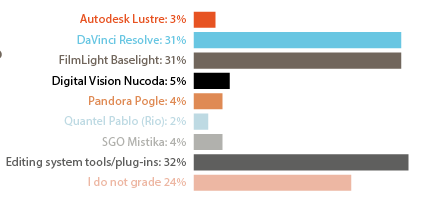
DaVinci’s Resolve and FilmLight’s Baselight were the two most popular colour-correction suites in the past 12 months in the UK broadcast industry, each with a 31% share.
An interesting point here is the massive percentage (32%) of professionals using plugins and editing tools to colour grade their work, which is something present in the Adobe CC suite for example, and chances are we’ll become more popular in the next 12 months as companies add more and more features into their existing software/apps in order to get ahead of the competition.
3. The Future of 4K in the TV Production Industry in the UK as of 2014
Here’s probably the most interesting part of the survey for us. The big question – “Where is 4K going in the world of broadcast, commercials, music videos and corporate work?”
The charts below do give some interesting insights into the thinking of major production companies operating in the UK.

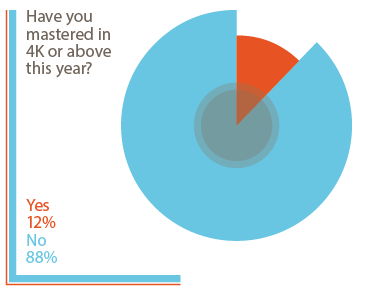
The lag in consumer adoption of 4K televisions combined with the general lack of 4K content for people to watch at home may be considered a contributing factor as almost everything that’s shot in 4K is delivered in HD for broadcast. 1 in 3 of those asked, plans to shoot in 4K next year on cameras like the Sony PMW-F55 and RED Epic for example.
In addition most responded that their goal with shooting in 4K resolutions or above, is to ensure their material is future proof for future broadcast/home entertainment delivery at higher resolutions. Only 12% of those who shot in 4K actually mastered in the same resolution or above if they shot in 5K or 6K. Content included, as expected, feature films and documentary/branded content intended for cinema exhibition.
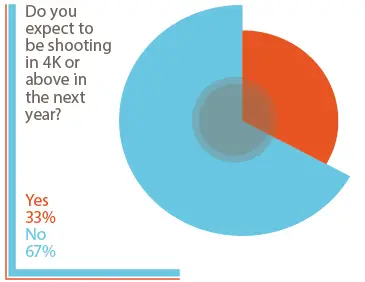
33% percent expect to be shooting in 4K or above in the next 12 months, which is an indication as to where the industry is headed. Production companies shoot what broadcasters and their corporate clients want. The more 4K content is demanded by commissioners of content and major broadcasters, the more production companies would be delivering this content by shooting in 4K or above and mastering at UHD (3840 x 2160p).
You can look at also the sheer evidence in camera specs of new cameras. Almost every new professional camera announced this year is either a 4K native camera, or a 4K “ready” camera, waiting for that future upgrade to satisfy the demand for 4K content, which is slowly gaining momentum. As 4K TV’s become more affordable, 4K home media such as a 4K blu-ray for example would propel 4K content creation in the near future.
[via Cinescopophilia & Televisual]
Disclaimer: As an Amazon Associate partner and participant in B&H and Adorama Affiliate programmes, we earn a small comission from each purchase made through the affiliate links listed above at no additional cost to you.




